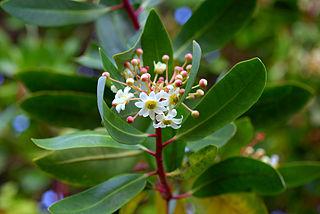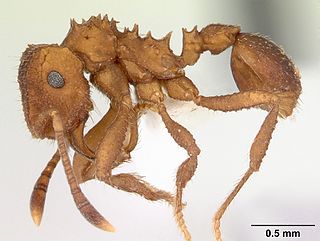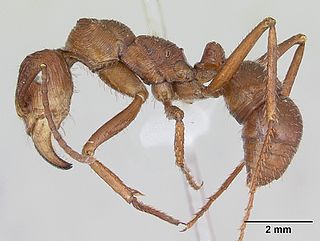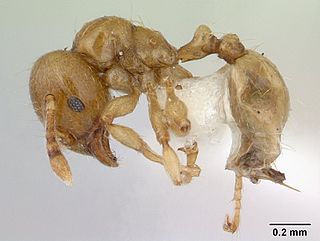
Drimys is a genus of seven species of woody evergreen flowering plants, in the family Winteraceae. The species are native to the Neotropics, ranging from southern Mexico to the southern tip of South America. They are primitive dicots, associated with the humid temperate Antarctic flora of the Southern Hemisphere, which evolved millions of years ago on the ancient supercontinent of Gondwana. Members of the family generally have aromatic bark and leaves, and some are used to extract essential oils.

Myrmicinae is a subfamily of ants, with about 140 extant genera; their distribution is cosmopolitan. The pupae lack cocoons. Some species retain a functional sting. The petioles of Myrmicinae consist of two nodes. The nests are permanent and in soil, rotting wood, under stones, or in trees.

The silky anteater, also known as the pygmy anteater, has traditionally been considered a single species of anteater, Cyclopes didactylus, in the genus Cyclopes, the only living genus in the family Cyclopedidae. Found in southern Mexico, and Central and South America, it is the smallest of all known anteaters. It has nocturnal habits and appears to be completely arboreal; its hind feet are highly modified for climbing.

Farlowella is a genus of fish in the family Loricariidae native to South America. This genus is broadly distributed in Amazon, Orinoco, Paraná and coastal rivers of the Guyana Shield. It is absent from the Pacific slope of the Andes and from the coastal rivers of the Brazilian Shield. Many of these species are kept in aquariums. This genus has a unique body shape that resembles a thin stick of wood. The body is slender and elongate, often with a pronounced rostrum and a brownish color with two lateral dark stripes beginning at the tip of the rostrum, passing over the eyes and ending at the tail, which are periodically interrupted on the caudal peduncle.

The black-bellied cuckoo or black-bellied squirrel cuckoo is a bird of the family Cuculidae found in the Amazon region. Even though this species has a wide distribution, little is known about its ecology and natural history. The word melanogaster means "black belly"; it has Greek roots, melas meaning "black" and gaster meaning "belly".

Mycocepurus is a Neotropical genus of fungus-growing ants in the subfamily Myrmicinae. The genus is known from Mexico, south to Brazil and Argentina. Like other attines, they primarily grow fungi of the tribe Leucocoprini. They use many different substrates for growing their fungi, from dry leaves and caterpillar dung to fruit matter. One of its species, Mycocepurus smithii, which lives in South America, reproduces by cloning – all ants in a colony are clones of the queen. M. castrator is a parasite of M. goeldii.

Thaumatomyrmex is a Neotropical genus of ants in the subfamily Ponerinae, found from Mexico to Brazil. They are notable for their pitchfork-shaped mandibles, which they use to capture millipedes of the order Polyxenida. The genus is a specialist predator of polyxenids, and one of only two ant genera known to prey upon polyxenids.
Lebiasina is a genus of fishes found in tropical South America, where they inhabit well-oxygenated upland streams that originate in the Andes of Colombia, Ecuador and Peru, the Guianan Highlands in Brazil, Guyana and Venezuela, and Serra do Cachimbo in Brazil. The individual species tend to have relatively small ranges and the three species of Serra do Cachimbo, all restricted to the Curuá River basin, are considered threatened by Brazil's Ministry of the Environment.
Capirona is a monotypic genus of flowering plants in the family Rubiaceae. The genus contains only one species, viz. Capirona decorticans, which is native to northern South America. It has been reported from French Guiana, Guyana, Suriname, Venezuela, Colombia, Ecuador, Perú, and northern Brazil.

Ectatomma is a Neotropical genus of ants in the subfamily Ectatomminae. The genus contains 17 described extant species and one extinct species.

Sphinctomyrmex is a genus of ants in the subfamily Dorylinae. The genus is a tropical and distinctive group, originally described by Mayr based on a single gyne collected in Brazil. Morphologically, the genus is characterized by the unique arrangement of the gastric segments, which are nearly equal in length and separated from each other by distinct constrictions. Very little is known on the natural history of Sphinctomyrmex. The few observations so far suggest that ants of this genus are nomadic predators of other ants. The genus Zasphinctus and approximately 20 species were formerly included, but were split out during revision of the Dorylinae genera by Borowiec (2016).

Lachnomyrmex is a Neotropical genus of ants in the subfamily Myrmicinae. The genus consists of 16 species restricted to the Neotropics, known from southern Mexico to northern Argentina. They are most often found in the leaf litter of wet forests, with nests located on the ground. Workers forage alone, apparently without recruiting nestmates or using pheromones. Within the tribe Stenammini, they seem to be most closely related to the genera Lordomyrma of Indo-Australia and Cyphoidris of Africa.

Allomerus is a Neotropical genus of small ants in the subfamily Myrmicinae. Its eight species are known from the forests of South America, where they live in plant cavities and structures.

Tranopelta is a Neotropical genus of ants in the subfamily Myrmicinae.

Stegomyrmex is a Neotropical genus of ants in the subfamily Myrmicinae. Strictly Neotropical in its distribution, the genus is known from Costa Rica to northern Argentina. It was once considered rare, but more recent sampling has revealed that the genus is relatively common in the leaf litter.
Megalomyrmex wallacei is a Neotropical species of ants in the subfamily Myrmicinae. Megalomyrmex wallacei can be found in Brazil, Guyana, Colombia, Costa Rica. This species occurs in mature wet forest, usually low-elevation rainforest. Brandão (2003) reports the species nesting under leaves on the forest floor, in colonies of up to 300 workers.
Sphinctomyrmex schoerederi is a Neotropical species of ants in the subfamily Dorylinae. S. schoerederi is known only from the holotype, collected in a leaf litter sample from a forest remnant in the campus of Universidade Federal de Viçosa in Brazil, where it occurs in sympatry with S. stali. Gynes and males are unknown.
Kempfidris is a Neotropical genus of ants in the subfamily Myrmicinae containing the single species Kempfidris inusualis. Known from Brazil, Ecuador and Venezuela, the species was originally described as Monomorium inusuale in 2007, but was reclassified as the type species for the new genus Kempfidris in 2014. The species is only known from workers and almost nothing is known about their natural history.

Zaretis itys, the skeletonized leafwing or leaf wing butterfly, is a Neotropical nymphalid butterfly genus in the subfamily Charaxinae.

Passiflora glandulosa, more commonly known as wild passion fruit, is a short deciduous climbing plant with stems that can grow up to 20 m (66 ft) long. The genus Passiflora is known for its colorful flowers, which is also prominent in the glandulosa species. Named by Antonio José Cavanilles in 1790, Passiflora glandulosa is native to many regions of the northeast coast of South America, having a neotropic distribution. In specific, Passiflora glandulosa is heavily populated in Guyana, Suriname, Brazil and French Guiana.















